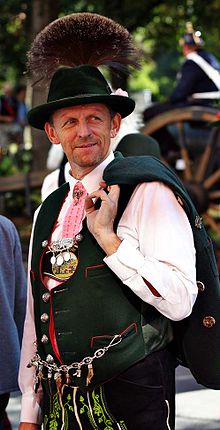Piping

The piping , more rarely of piping, from the French. Le Passepoil "on the fringe beyond what", especially in Austria and Switzerland masculine in the original writing (m.) Passepoil with the appropriate pronunciation [paspo̯al], even edging or venture called , is a narrow, beaded seam trim on items of clothing. Originally, the piping or piping was a reinforcement strip on military clothing. Since the 19th century, the edge piping has mainly served as a decoration. Piping emphasizes the contour and cut of the garment.
The piping consists of a lengthwise folded strip of fabric , between the layers of which a cord can be inserted. The piping is carried along when the seam of an item of clothing is closed , so that the breaking edge of the strip is visible from the outside as a small bead that emphasizes the seam line. A distinction is made between the edge piping and the pocket piping.
Edge piping
The edge piping is also called border or protrusion . It is used to decorate edges, hems and slits. The strip of fabric is pre-sewn, folded over and quilted on the relevant edge . The visible width is up to three millimeters.
In the 19th century, piping was quite common in women's clothing. Today they are mainly used in traditional costume or country house fashion , uniforms and pajamas . The approximately 10 cm wide piping at the lower end of a dirndl is known as the smock sheet and is mainly attached to festive dirndl dresses. With shoes, piping is incorporated into the edges of the entry as a mark of quality.
Pocket piping
The pocket piping serves to clean up and stabilize the pocket opening. It is wider than the edge piping and tailored to the shape of the outer fabric or lining. There are also pocket piping machines. - This technique is also used to make piping buttonholes on jackets and coats.
Uniforms

In uniforms, piping is sometimes also referred to as advances.
For uniforms, piping (piping - in the Austro-Hungarian Army also passepoiling) of different colors is used to distinguish the uniform wearers from one another according to the type of weapon or other criteria (see also equalization ). Common external characteristic of the service level group of the NCOs with Portepee is in the armed forces a Kordelierung from an old gold cord on the uniform collar of the service suit . This cord is silver-colored for officers and gold-colored for generals.
Piping were originally the preserve of the trouser fabric, than it was in some branches of service , the trouser legs of Overtrousers were open at the side seam and buttoned had. The seam of the trim , which was often a different color, was allowed to protrude outwards. After the trouser legs had also been sewn in the side seam, the advance was retained. At the beginning of the 19th century it became customary to provide both long uniform trousers (previously the military wore knee trousers ) and riding breeches with piping.
- The Prussian infantry wore red piping on their normal uniform trousers until 1914. The white parade trousers - which only certain regiments were allowed to wear - had no piping.
- In the Bundeswehr , piping in the color of weapons (infantry = green, armored troops = pink, etc.) had been worn since 1962, but was discontinued on trousers in the early 1970s.
- The uniforms of the GDR had piping right up to the end.
- In Germany you can find piping on many fire department uniforms, on police pants in some countries (e.g. Lower Saxony and Hamburg) and on unofficial uniforms such as those of the rifle and carnival clubs .
At tunics piping were processed to:
- front edge
- Flank seam
- collar
- Collar foot
- back sleeve seam
- Envelopes
- Sleeve flaps
- Flap or flap edges
- Buttonholes (piped buttonholes)
- Shoulder pieces
- Collar mirror and lapel mirror
- upper third of the sleeve insert seam
literature
- Maggy Baum, Chantal Boyeldieu-Duyek: Passepoil, piqures et paillettes. Dictionnaire du fil, des aiguilles et des étoffes. Le Seuil, Paris 2008, ISBN 9782020979979 .
- Oskar Brüch: The Kuk Heer in 1895. Stocker Verlag, Graz 1997.
- Richard Knötel, Herbert Knötel the Elder J., Herbert Sieg, Ingo Prömperm: Colored Handbook of Uniform Studies , Volume 1: The development of the military costume of the German states, Austria-Hungary and Switzerland up to 1937. Augsburg 1996.
Web links
Individual evidence
- ↑ Duden: [1]
- ↑ Wilfried Schierbaum: Bekleidungs-Lexikon, Berlin: Schiele & Schoen 1993, p. 310. ISBN 3-7949-0563-6
- ↑ http://www.zeno.org/Pierer-1857/A/Passepoil
- ↑ Wilfried Schierbaum: Bekleidungs-Lexikon, Berlin: Schiele & Schoen 1993, p. 310. ISBN 3-7949-0563-6
